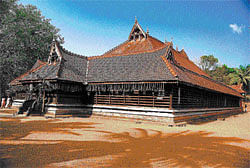
We arrived at Kerala Kalamandalam in Cheruthuruthi, a few miles from Shoranur, at 9 am. It had rained the night before and the air was hushed, expectant and damp on the sprawling 32-acre campus on the banks of River Bharatapuzha, the spiritual and emotional heart of Kerala. Squirrels run up and down the tall trees; our guide identifies one tree as that under which yakshis — Kerala’s own demonesses — live. Appropriately enough, legends mingle with the mystic in this leafy deemed university established by the visionary poet, Vallathol Narayana Menon, in 1927 when he registered a new society in Calicut and called it the Kerala Kalamandalam.
The story of the mahakavi, as he was known, finds passionate articulation in the words of Nibha Namboodirippad, who works with the Kalamandalam. In her opinion, the great poet not only resuscitated and rejuvenated the Kerala arts, but also, in the process, contributed greatly to the concept of social justice by making possible the performances of dances such as Mohiniattam, which had fallen into disrepute, into a form which respectable young women could practice. He even persuaded his own kith and kin to learn so that they could set stellar examples for others to follow.
It is said that his shock at the deplorable state of Kathakali, after attending a lacklustre performance at a friend’s house in Kunnamkulam, was the motivating factor in his setting up this revered institution.
The times then were not auspicious for any kind of ventures, but he laboured, and in 1930 he was able to commence operations at the house of a patron at Kunnamkulam.
And when he felt the need for more space and amenities, his friend and colleague, Mukunda Raja, offered his premises at Ambalapuram. Believing that artists should have a knowledge of classical literature and the epics to be able to express themselves well, he persuaded renowned scholars to join the institution. In 1937, the present premises started functioning. It is a tribute to his determination and faith in overcoming not only external obstacles such as resources, but also his own difficulties — the mahakavi struggled with deafness.
It was a really memorable day for us to take advantage of a programme called “A Day With the Masters”, starting from the impassioned talk given to us by Nibha to acquaint us with the vision of the great poet. We were taken on a leisurely stroll to the kalaris and the koothambalam, returning to the office via the dramatic mural drawing attention to dance and its manifold aspects and the statue of Vallathol in a peaceful site surrounded by greenery.
And everywhere in the leafy campus with great trees we saw and heard the articulation of that vision. Musical instruments such as the maddalam, mizhavu, thimile, chenda and edakka formed an accompaniment to the bird calls and leaf rustles. Anklets heralded the dancers before we saw them. Drums resounded. Cymbals clashed and choruses of voices lifted themselves into air.
It was also very inspiring to see hordes of school children being brought to the campus to acquaint them to traditional performing arts. According to one of the teachers, “Even if one child from one visit is inspired to join, Vallathol’s purpose will be achieved.”
Unfortunately, we could not see the young students (aged 12 upwards) perform, as they were writing an exam.
In the kalaris or small classrooms which, like nurturing wombs, promote intimacy and atmosphere, dancers, musicians and make-up artistes were rehearsing their craft. Each kalari seemed to have its own uniform — blue with red bordered saris, green with yellow, etc. And while they danced and sang, dedicated teachers watched every nuance and subtle movement to hone these ancient dances. Young faces gleamed with devotion and sweat. And in each class, one sees different aspects of training and performing — all the movements of dance with torso, limbs and eyes.
The mahakavi understood the importance of the ancient gurukula system which elevates the training process with intangible rooted values of trust, devotion and discipline.
Students observe a rigid regimen, getting up at 4 or 5 am to bathe and pray and discipline themselves prior to the classes. And the result was visible in their exuberant movements and flashing eyes. Training co-exists with academic qualifications.
In the make-up kalari, budding artistes were painting on earthen pots to get the symbolic expressions using vegetable colours of green, red and black to symbolise the different characteristics of nobility, greed and wickedness, while some were learning about ornamentation. No detail is overlooked for everything has a meaning and significance. And everywhere, traditional oil lamp is ubiquitous, providing sanctity to whatever action or word is communicated in the course of instruction and absorption.
While Vallathol concentrated on Kathakali and Mohiniattam, he also introduced Kudiyattam into the syllabus in 1965 as it was an ancient dance drama form dating back to the 12th century. Other dance forms practiced were Bharatanatyam, Thullal and Kuchipudi.
However, the piece de resistance for me was the koothambalam, the ancient temple theatre for make-up, costuming and performing these dance forms. The koothambalam is usually constructed in accordance with instructions contained in classical texts. The one in Kalamandalam is a delight to the eyes, even though it is still being enhanced with its granite pillars with 108 dance poses from the Natyasastra. The hall is spacious and the woodwork of the louvers is elegantly executed. Hanging lamps provide illumination for the stage.
Vallathol’s statue and samadhi are here, enshrined in the temple of arts which he conceived and laboured to establish, and had he been alive, I am sure he would have been happy to see it attracting artistes from not only India, but from all over the world, to learn, absorb and express.
There is a spiritual energy about Kalamandalam which is translated into dedication and devotion in the students and their mentors, a devotion that is unalloyed and complete — an invaluable legacy of the great poet’s vision.